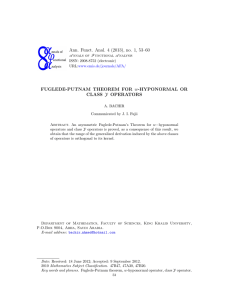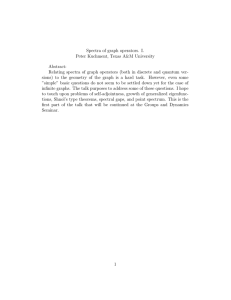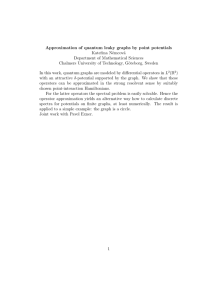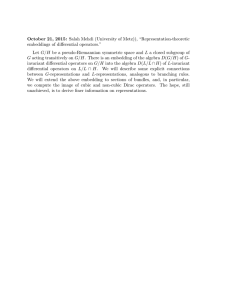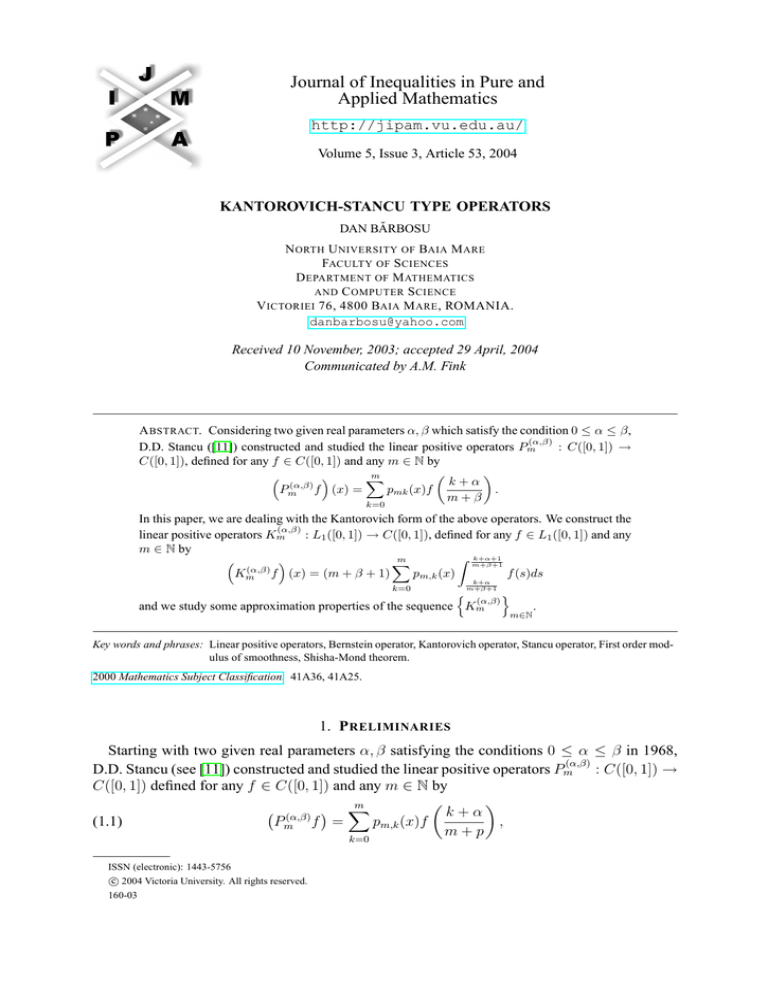
Journal of Inequalities in Pure and
Applied Mathematics
http://jipam.vu.edu.au/
Volume 5, Issue 3, Article 53, 2004
KANTOROVICH-STANCU TYPE OPERATORS
DAN BĂRBOSU
N ORTH U NIVERSITY OF BAIA M ARE
FACULTY OF S CIENCES
D EPARTMENT OF M ATHEMATICS
AND C OMPUTER S CIENCE
V ICTORIEI 76, 4800 BAIA M ARE , ROMANIA.
danbarbosu@yahoo.com
Received 10 November, 2003; accepted 29 April, 2004
Communicated by A.M. Fink
A BSTRACT. Considering two given real parameters α, β which satisfy the condition 0 ≤ α ≤ β,
(α,β)
D.D. Stancu ([11]) constructed and studied the linear positive operators Pm
: C([0, 1]) →
C([0, 1]), defined for any f ∈ C([0, 1]) and any m ∈ N by
m
X
k+α
(α,β)
.
Pm f (x) =
pmk (x)f
m+β
k=0
In this paper, we are dealing with the Kantorovich form of the above operators. We construct the
(α,β)
linear positive operators Km
: L1 ([0, 1]) → C([0, 1]), defined for any f ∈ L1 ([0, 1]) and any
m ∈ N by
k+α+1
Z m+β+1
m
X
(α,β)
Km f (x) = (m + β + 1)
pm,k (x)
f (s)ds
k=0
k+α
m+β+1
n
o
(α,β)
and we study some approximation properties of the sequence Km
m∈N
.
Key words and phrases: Linear positive operators, Bernstein operator, Kantorovich operator, Stancu operator, First order modulus of smoothness, Shisha-Mond theorem.
2000 Mathematics Subject Classification. 41A36, 41A25.
1. P RELIMINARIES
Starting with two given real parameters α, β satisfying the conditions 0 ≤ α ≤ β in 1968,
(α,β)
D.D. Stancu (see [11]) constructed and studied the linear positive operators Pm : C([0, 1]) →
C([0, 1]) defined for any f ∈ C([0, 1]) and any m ∈ N by
m
X
k+α
(α,β)
(1.1)
Pm f =
pm,k (x)f
,
m
+
p
k=0
ISSN (electronic): 1443-5756
c 2004 Victoria University. All rights reserved.
160-03
2
DAN BĂRBOSU
k
where pm,k (x) = m
x (1 − x)m−k are the fundamental Bernstein polynomials ([5]).
k
The operators (1.1) are known in mathematical literature as "the operators of D.D. Stancu"
(see ([2])).
(0,0)
Note that for α = β = 0, the operator Pm is the classical Bernstein operator Bm ([5]).
In 1930, L.V. Kantorovich constructed and studied the linear positive operators Km : L1 ([0, 1])
→ C([0, 1]) defined for any f ∈ L1 ([0, 1]) and any non-negative integer m by
Z k+1
m
X
m+1
(1.2)
(Km f ) (x) = (m + 1)
pm,k (x)
f (s)ds.
k
m+1
k=0
The operators (1.2) are known as the Kantorovich operators. These operators are obtained from
the classical Bernstein operators (1.1), replacing there the value f (k/m) of the approximated
function by the integral of f in a neighborhood of k/m.
(α,β)
Following the ideas of L.V. Kantorovich ([7]), let us consider the operators Km : L1 ([0, 1])
→ C([0, 1]), defined for any f ∈ C([0, 1]) and any m ∈ N by
Z k+α+1
m
X
m+β+1
(α,β)
(1.3)
Km f (x) = (m + β + 1)
pm,k (x)
f (s)ds
k+α
m+β+1
k=0
obtained from the Stancu type operators (1.1).
Section 2 provides some interesting approximation properties of operators (1.3), called
"Kantorovich-Stancu type operators" because they are obtained starting from the Stancu type
operators (1.1) following Kantorovich’s ideasn(see alsooG.G. Lorentz [9]).
(α,β)
A convergence theorem for the sequence Km f
is proved and the rate of converm∈N
gence under some assumptions on the approximated function f is evaluated.
2. M AIN R ESULTS
Lemma 2.1. The Kantorovich-Stancu type operators (1.3) are linear and positive.
Proof. The assertion follows from definition (1.3).
In what follows we will denote by ek (s) = sk , k ∈ N, the test functions.
Lemma 2.2. The operators (1.3) verify
(α,β)
(2.1)
Km
e0 (x) = 1,
α
m+β
m
(α,β)
Km
e1 (x) =
(2.2)
x+
+
,
m+β+1
m + β + 1 2(m + β + 1)2
1
2αm2
α2 (3m + β)
(α,β)
2 2
Km e2 (x) =
m x + mx(1 − x) +
+
(m + β + 1)2
m+β
m+β
1
1
(2.3)
+
{mk + α} +
2
(m + β + 1)
3(m + β + 1)2
for any x ∈ [0, 1].
Proof. It is well known (see [11]) that the Stancu type operators (1.1) satisfy
Pm(α,β) e0 (x) = 1
m
α
Pm(α,β) e1 (x) =
x+
m+β
m+β
1
αm2
3α2 m
(α,β)
2 2
Pm e2 (x) =
m x + mx(1 − x) + 2
x+
(m + β)2
m+β
m+β
J. Inequal. Pure and Appl. Math., 5(3) Art. 53, 2004
http://jipam.vu.edu.au/
K ANTOROVICH -S TANCU T YPE O PERATORS
3
Next we apply the definition (2.1).
Lemma 2.3. The operators (1.3) satisfy
(α,β)
(2.4) Km
((e1 − x)2 ; x) =
m
(β + 1)2
2
x
+
x(1 − x)
(m + β + 1)2
(m + β + 1)2
m
+
{m + 2α(m − β − 1)}x
(m + β + 1)2 (m + β)
3α2 (3m + β) + (m + β)(1 − 3m − 3β)
+
3(m + β)(m + β + 1)2
for any x ∈ [0, 1].
(α,β)
Proof. From the linearity of Km
, we get
(α,β)
(α,β)
(α,β)
(α,β)
e0 (x)
Km
((e1 − x)2 ; x) = Km
e2 (x) − 2x Km
(e1 ; x) + x2 Km
Next, we apply Lemma 2.2.
n
o
(α,β)
Theorem 2.4. The sequence Km f
converges to f , uniformly on [0, 1], for any f ∈
m∈N
L1 ([0, 1]).
Proof. Using Lemma 2.3, we get
(α,β)
lim Km
((e1 − x)2 ; x) = 0
m→∞
uniformly on [0, 1]. We can then apply the well known Bohman-Korovkin Theorem (see [6]
and [8]) to obtain the desired result.
n
o
(α,β)
Next, we deal with the rate of convergence for the sequence Km f
, under some asm∈N
sumptions on the approximated function f . In this sense, the first order modulus of smoothness
will be used.
Let us recall that if I ⊆ R is an interval of the real axis and f is a real valued function defined
on I and bounded on this interval, the first order modulus of smoothness for f is the function
ω1 : [0, +∞) → R, defined for any δ ≥ 0 by
(2.5)
ω1 (f ; δ) = sup {|f (x0 ) − f (x00 )| : x0 , x00 ∈ I, |x0 − x00 | ≤ δ} .
For more details, see for example [1].
Theorem 2.5. For any f ∈ L1 ([0, 1]), any α, β ≥ 0 satisfying the condition α ≤ β and each
x ∈ [0, 1] the Kantorovich-Stancu type operators (1.3) satisfy
q
(α,β)
(α,β)
(2.6)
Km f (x) − f (x) ≤ 2ω1 f ; δm (x) ,
where
(2.7)
(α,β)
(α,β)
δm
(x) = Km
((e1 − x)2 ; x)
J. Inequal. Pure and Appl. Math., 5(3) Art. 53, 2004
http://jipam.vu.edu.au/
4
DAN BĂRBOSU
Proof. From Lemma 2.2 follows
m+p Z
X
(α,β)
(2.8)
Km f (x) − f (x) ≤ (m + β + 1)
k=0
k+α+1
m+β+1
|f (s) − f (x)|ds
k+α
m+β+1
On the other hand
|f (s) − f (x)| ≤ ω1 (f ; |s − x|) ≤ (1 + δ −2 (s − x)2 )ω1 (f ; δ).
For |s − x| < δ, the lost increase is clear. For |s − x| ≥ δ, we use the following properties
ω1 (f ; λδ) ≤ (1 + λ)ω1 (f ; δ) ≤ (1 + λ2 )ω1 (f ; δ),
where we choose λ = δ −1 · |s − x|.
This way, after some elementary transformation, (2.8) implies
(α,β) (α,β)
(α,β)
Km
((e1 − x)2 ; x ω1 (f ; δ)
(2.9)
f (x) − f (x) ≤ Km
e0 (x) + δ −2 Km
for any δ > 0 and each x ∈ [0, 1].
Using next Lemma 2.2 and Lemma 2.3, from (2.9) one obtains
(α,β)
(α,β)
Km
(2.10)
f (x) − f (x) ≤ 1 + δ −2 δm
(x) ω1 (f ; δ)
for any δ ≥ 0 and each x ∈ [0, 1].
(α,β)
Taking into account Lemma 2.1, it follows that δm (x) ≥ 0 for each x ∈ [0, 1]. Consequently,
(α,β)
we can take δ := δm (x) in (2.9), arriving at the desired result.
Theorem 2.6. For any f ∈ L1 ([0, 1]) and any x ∈ [0, 1] the following
q
(α,β)
(α,β)
(2.11)
Km f (x) − f (x) ≤ 2ω1 f ; δm , 1
holds, where
(α,β)
(2.12) δm,1 =
(β + 1)2
m2 (2α + 1)
m
+
+
2
2
(m + β + 1)
(m + β)(m + β + 1)
4(m + β + 1)2
3α2 (3m + β) + (m + β)(1 − 3m − 3β)
+
.
3(m + β)(m + β + 1)2
Proof. For any x ∈ [0, 1], the inequality
(α,β)
(α,β)
((e1 − x)2 ; x) ≤ δm,1
Km
holds. Consequently, applying Theorem 2.5 we get (2.11).
Remark 2.7. Theorem 2.5 gives us the order of local approximation (in each point x ∈ [0, 1]),
while Theorem 2.6 contains an evaluation for the global order of approximation (in any point
x ∈ [0, 1]).
(α,β)
Because the maximum of δm (x) from (2.6) depends on the relations between α and β, it
follows that it can be refined further.
Taking into account the inclusion C([0, 1]) ⊂ L1 ([0, 1]), as consequences of Theorem 2.5 and
Theorem 2.6, follows the following two results.
Corollary 2.8. For any f ∈ C([0, 1]), any α, β ≥ 0 satisfying the condition α ≤ β and each
x ∈ [0, 1], the inequality (2.6) holds.
Corollary 2.9. For any f ∈ C([0, 1]), any α, β ≥ 0 satisfying the condition α ≤ β and any
x ∈ [0, 1], the inequality (2.11) holds.
Further, we estimate the rate of convergence for smooth functions.
J. Inequal. Pure and Appl. Math., 5(3) Art. 53, 2004
http://jipam.vu.edu.au/
K ANTOROVICH -S TANCU T YPE O PERATORS
5
Theorem 2.10. For any f ∈ C 1 ([0, 1]) and each x ∈ [0, 1] the operators (1.3) verify
(α,β)
(2.13) Km
f (x) − f (x)
m
+
β
β
+
1
−
x
≤ |f 0 (x)| · 2(m + β + 1)2 (m + β + 1)2 q
q
(α,β)
(α,β)
0
+ 2 2δm (x)ω1 f ; δm (x) ,
(α,β)
where δm
(x) is given in (2.7).
Proof. Applying a well known result due to O. Shisha and B. Mond (see [10]), it follows that
(α,β)
(α,β)
(2.14) Km
f (x) − f (x) ≤ |f (x)| · Km
e0 (x) − 1
q
(α,β)
0
(α,β)
(α,β)
+ |f (x)| · Km e1 (x) − x Km e0 (x) + Km ((e1 − x)2 ; x)
(r
)
q
(α,β)
(α,β)
×
Km e0 (x) + δ −1 Km ((e1 − x)2 ; x) ω1 (f 0 ; δ).
From (2.14), using Lemma 2.2 and Lemma 2.3, we get
β+1
m+β
(α,β)
0
(2.15)
Km f (x) − f (x) ≤ |f (x)| · −
(m + β + 1)2 (m + β + 1)2 x q
q
(α,β)
(α,β)
−1
+ δm (x) 1 + δ
δm (x) ω1 (f 0 ; δ).
q
(α,β)
Choosing δ = δm (x) in (2.15), we arrive at the desired result.
Theorem 2.11. For any f ∈ C 1 ([0, 1]) and any x ∈ [0, 1] the operators (1.3) verify
√ √
m+β
(α,β)
0
Km
(2.16)
f (x) − f (x) ≤
M
+
2
δω
1
1 f ; δ ,
(m + β + 1)2
where
(α,β)
M1 = max |f 0 (x)|, δ = max δm
(x) .
x∈[0,1]
x∈[0,1]
Proof. The assertion follows from Theorem 2.10.
Remark 2.12. Because δ depends on the relation between α and β, (2.16) can be further refined,
following the ideas of D.D. Stancu [11, 12].
R EFERENCES
[1] O. AGRATINI, Aproximare prin operatori liniari (Romanian), Presa Universitară Clujeană, ClujNapoca, 2000.
[2] F. ALTOMARE AND M. CAMPITI, Korovkin-type Approximation Theory and its Applications, de
Gruyter Series Studies in Mathematics, vol. 17, Walter de Gruyter & Co. Berlin, New-York, 1994.
[3] D. BĂRBOSU, A Voronovskaja type theorem for the operator of D.D. Stancu, Bulletins for Applied
& Computer Mathematics, BAM 1998-C/2000, T.U. Budapest (2002), 175–182.
[4] D. BĂRBOSU, Kantorovich-Schurer operators (to appear in Novi-Sad Journal of Mathematics)
[5] S.N. BERNSTEIN, Démonstration du théorème de Weierstrass fondée sur le calcul de probabilités,
Commun. Soc. Math. Kharkow, 13(2) (1912-1913), 1–2.
J. Inequal. Pure and Appl. Math., 5(3) Art. 53, 2004
http://jipam.vu.edu.au/
6
DAN BĂRBOSU
[6] H. BOHMAN, On approximation of continuous and analytic functions, Ark. Mat., 2 (1952), 43–56.
[7] L.V. KANTOROVICH, Sur certain développements suivant les polynômes de la forme de S. Bernstein, I, II, C.R. Acad. URSS (1930), 563–568, 595–600.
[8] P.P. KOROVKIN, On convergence of linear operators in the space of continuous functions (Russian), Dokl. Akad. Nauk. SSSR (N.S.), 90 (1953), 961–964.
[9] G.G. LORENTZ, Bernstein Polynomials, Toronto: Univ. of Toronto Press, 1953.
[10] O. SHISHA AND B. MOND, The degree of convergence of linear positive operators, Proc. Nat.
Acad. Sci. U.S.A, 60 (1968), 1196–2000.
[11] D.D. STANCU, Approximation of function by a new class of polynomial operators, Rev. Roum.
Math. Pures et Appl., 13(8) (1968), 1173–1194.
[12] D.D. STANCU, Asupra unei generalizări a polinoamelor lui Bernstein (Romanian), Studia Universitatis Babeş-Bolyai, 14(2) (1969), 31–45.
[13] D.D. STANCU, GH. COMAN, O. AGRATINI AND R. TRˆIMBIŢAŞ, Analiză Numerică şi Teoria
Aproximării, Vol.I (Romanian), Presa Universitară Clujeană, Cluj-Napoca, 2001.
J. Inequal. Pure and Appl. Math., 5(3) Art. 53, 2004
http://jipam.vu.edu.au/

